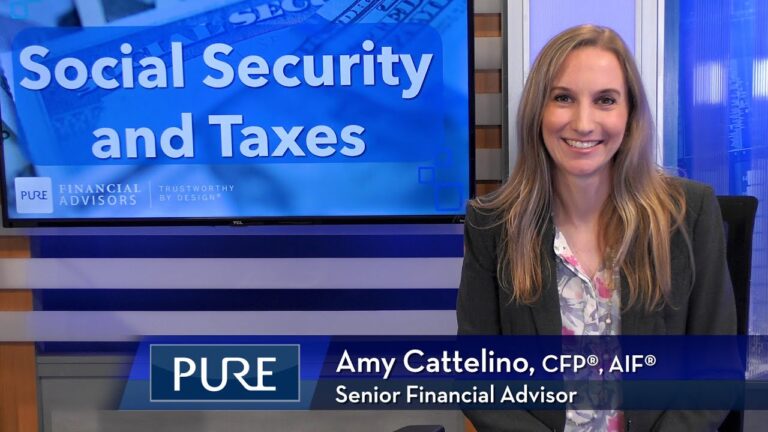Secure 2.0 aims to expand coverage and increase retirement savings for employees. Peter Stokes CFP®, AIF®, Pure Financial Planner, Los Angeles branch, covers the key retirement provisions and how they may effect you.
FREE GUIDE | SECURE Act 2.0 Guide
Transcript
The Secure 2.0 act is now law. The legislation provides a slate of changes that could help strengthen the retirement system and Americans’ financial readiness for retirement. Here are the key retirement provisions of the new Secure Act 2.0
Raising the Starting Age for RMDs:
Effective Jan. 1, 2023, the threshold age that determines when individuals must begin taking required minimum distributions from Traditional IRAs and workplace retirement plans increases from 72 to 73. As a result, individuals now can choose to delay taking their first RMD until April 1st of the year following the year in which they reach age 73. From that point on, RMDs must be received each year by December 31st
An Increase in Catch-up Contributions:
The Secure 2.0 act bumps the maximum additional amount that can be contributed to a workplace IRA or 401(k) plan if you’re age 50 and older from $6,500 per year to $7,500 effective in 2023. In addition, if you’re ages 60 to 63, you’ll be able to add $10,000 more per year above the standard limit beginning in 2025.
Retirement Plan Contributions for those with Student Loan Debts:
A provision of Secure 2.0 that takes effect beginning in 2024 will allow employers to make contributions to workplace savings plans on behalf of employees who are still repaying student loans.
Rollovers of 529 Plan Balances to Roth IRAs:
Under prior law (still in effect in 2023), leftover balances in 529 education savings plans can be taken as a non-qualified distribution, but the earnings portion of the distribution is subject to income tax and a 10% penalty. Beginning in 2024, based on provisions in the new law, you’re allowed to roll up to $35,000 of leftover funds into a Roth IRA.
There are some caveats- rollovers would be subject to the Roth IRA annual contribution limits and the 529 would need to have been open for at least 15 years.
Changes to Roth Employer Plans:
Individuals can choose to have employer matching contributions directed to their Roth workplace accounts. These contributions will be considered taxable income in the year of the contribution. A provision in the Secure 2.0 act eliminates RMD requirements for workplace-based Roth plans beginning in 2024. This change results in Roth 401(k)s having similar treatment related to RMDs as Roth IRAs.
Establishment of a Saver’s Match:
The current “saver’s credit” program allows those meeting lower income thresholds to claim a tax credit for contributions made to workplace savings plan or IRAs. Effective in 2027, the credit is being replaced by a “saver’s match.” The match will equal up to 50% of the first $2,000 contributed by an individual to a retirement account each year (up to $1,000). This will be a federal matching deposited into the saver’s traditional retirement account.
Qualified Charitable Distributions (QCD):
Beginning in 2023, people who are age 70½ and older may elect as part of their QCD limit a one-time gift up to $50,000, adjusted annually for inflation, to a charitable remainder unitrust, a charitable remainder annuity trust, or a charitable gift annuity.
Penalty-Free Early Withdrawals:
There are new exceptions to the 10% early withdrawal penalty before age 59½ for terminal illness, survivors of domestic abuse, and corrective distributions of excess contributions and earnings. In 2026, you’ll also be able to make penalty-free early withdrawals for long term care premiums, up to $2500 per year.
Make sure you’re taking advantage of any new retirement reforms and tax breaks that impact you, your family, and your future. Schedule a free assessment with one of the experienced financial professionals at Pure Financial Advisors today.
Subscribe to our YouTube channel.
IMPORTANT DISCLOSURES:
• Investment Advisory and Financial Planning Services are offered through Pure Financial Advisors, LLC, a Registered Investment Advisor.
• Pure Financial Advisors LLC does not offer tax or legal advice. Consult with your tax advisor or attorney regarding specific situations.
• Opinions expressed are subject to change without notice and are not intended as investment advice or to predict future performance.
• Investing involves risk including the potential loss of principal. No investment strategy can guarantee a profit or protect against loss in periods of declining values.
• All information is believed to be from reliable sources; however, we make no representation as to its completeness or accuracy.
• Intended for educational purposes only and are not intended as individualized advice or a guarantee that you will achieve a desired result. Before implementing any strategies discussed you should consult your tax and financial advisors.
CFP® – The CERTIFIED FINANCIAL PLANNER™ certification is by the Certified Financial Planner Board of Standards, Inc. To attain the right to use the CFP® designation, an individual must satisfactorily fulfill education, experience and ethics requirements as well as pass a comprehensive exam. Thirty hours of continuing education is required every two years to maintain the designation.
AIF® – Accredited Investment Fiduciary designation is administered by the Center for Fiduciary Studies fi360. To receive the AIF Designation, an individual must meet prerequisite criteria, complete a training program, and pass a comprehensive examination. Six hours of continuing education is required annually to maintain the designation.












